Star Spangled GW
A Historic Election Year Highlights GW's Love Affair With Politics
From students and alumni to the faculty and staff, The George Washington University’s connections to the political system are unlike any other school. GW’s proximity to the action creates early bonds for students, who then as alumni become political leaders, strategists, and others. For the faculty and staff, GW provides a nearby base to study and assist with political campaigns and elections, and even contribute to research in such areas as polling and voting technology.
Here we share a few stories that illustrate how deeply this subject is woven into the University fabric.
Students
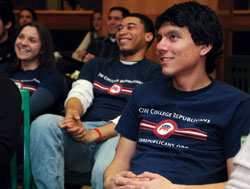
Members of the GW College Republicans gather to watch President George W. Bush’s State of the Union address in January 2008.
Jessica McConnell
GW has long taken pride in its reputation as one of the most politically engaged campuses in the nation, and the excitement was palpable this fall. Student activism soared as Colonials stumped for their candidates, created new campus political organizations, and gathered to watch voting results. Then the moment arrived—and hundreds of students celebrated the political process on election night by parading joyfully to the White House. In an election year when an invigorated youth movement swept the nation, GW students were leading the way.
“If anyone should be concerned about the future, it’s a college student,” says Brand Kroeger, chairman of the GW College Republicans. “It’s important we have our voices heard.”
Across campus, students show their political pride in a wide variety of ways. The University’s award-winning College Democrats and College Republicans chapters are thriving. Both groups worked hard to campaign for their respective presidential nominees this fall, with weekend campaign trips to states as far afield as Michigan and Ohio. The College Republicans, which celebrated its 100th anniversary on campus this year, held barbeques in Kogan Plaza and organized a visit by former Sen. Trent Lott (R.-Miss.). The College Democrats showed their passion, too, by canvassing Virginia and Ohio neighborhoods for president-elect Barack Obama (D.-Ill.) and organizing a number of events during the week leading up to the election.
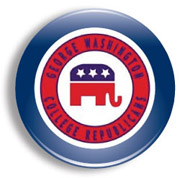 To ensure that no GW students remained on the sidelines this historic election year, the Student Association conducted a campus-wide voter registration drive called Student VOTES, which registered an estimated 1,200 new voters. “They had tables with laptops set up at all the major student events this fall, where students could register to vote on the spot,” says Tim Miller, executive director of the Student Activities Center.
To ensure that no GW students remained on the sidelines this historic election year, the Student Association conducted a campus-wide voter registration drive called Student VOTES, which registered an estimated 1,200 new voters. “They had tables with laptops set up at all the major student events this fall, where students could register to vote on the spot,” says Tim Miller, executive director of the Student Activities Center.
At last count, 45 student organizations on campus identify themselves as political in nature, and Miller says that number is sure to rise this academic year. He estimates that the University will soon boast about 55 to 60 politically oriented student organizations because of the passion students had for the presidential election.
“Being actively involved in a political organization is the most important thing a student can do on campus, especially at this critical historical juncture,” says Matt Ingoglia, communications director for the GW College Democrats.
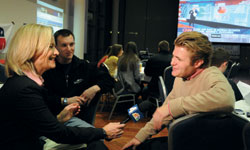
Julie Carey from NBC 4 in Washington interviews a student during a GW “watch party” for the Feb. 5 “Super Tuesday” primary elections.
Jessica McConnell
More than 500 students literally live politics at Thurston Hall’s interdisciplinary politics and public policy theme house for freshmen. “They live together on the same floors at Thurston and participate collectively in politically oriented events, like presidential debate watching parties and field trips around Washington that engage them in conversations about the political process,” says Andrew Goretsky, director of House Life at GW Housing Programs. “Many of the programs are student-driven, helping participants become involved, responsible members of the community.”
Groups of students interested in delving deeply into specific themes related to politics are encouraged to create Living and Learning Cohorts (LLCs) in the residence halls. “This year, 24 sophomores formed an LLC focusing on political satire, and in recent years, we’ve had LLCs focusing on topics ranging from ‘The West Wing’ to ‘Harry Potter for President,’ ” Goretsky says.
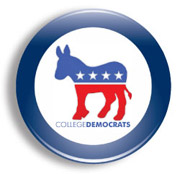 To encourage students to rock the vote, the Student Activities Center held an online mock election on Oct. 2—complete with campaigning on Kogan Plaza along with an election night, CNN-style results extravaganza. “We treated it as an actual election night, with precincts reporting and projected maps changing colors as the votes come in,” Miller says. “The mock election was held the same night as the vice presidential debates, so we’ll go straight from the election to a debate viewing party, followed by the results party.”
To encourage students to rock the vote, the Student Activities Center held an online mock election on Oct. 2—complete with campaigning on Kogan Plaza along with an election night, CNN-style results extravaganza. “We treated it as an actual election night, with precincts reporting and projected maps changing colors as the votes come in,” Miller says. “The mock election was held the same night as the vice presidential debates, so we’ll go straight from the election to a debate viewing party, followed by the results party.”
GW students celebrated Election Day as a community with results parties in the Marvin Center sponsored by the College Democrats and Republicans. After the results were in, the campus shifted its focus to Inauguration Day festivities, such as the much-loved GW Inaugural Ball, one of the University’s most glamorous traditions, being held this year on Jan. 20 at the Omni Shoreham Hotel.
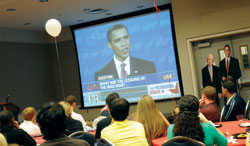
In October, students watch the first presidential debates.
Jessica McConnell
When Inauguration Day comes, GW students want to be part of the action. The Student Association has applied to have a float in the Inaugural Parade, which, if approved, will be the first time that GW has been a part of the parade since President Truman’s inauguration in 1949.
Only institutions chartered by Congress can enter floats in the parade, which means GW and American University are the only eligible universities in the nation, explains senior Charlie Burgoyne, Student Association executive director of programming and activities. Burgoyne worked with professors Stephen Pothier and Roger Cortesi of GW’s Department of Mechanical Engineering and ceramics professor Turker Ozdogan to draft a design of an 8.5-foot-wide, 34-foot-long float.
If the float application is accepted, Burgoyne hopes to involve as many students in the project as possible. “My goal is to have each school represented by a design on the float,” he says. “I hope to have students participate in every way so we can get this campus excited and united.”
It’s just one of the many opportunities GW students have by virtue of the University’s location, Miller says. “GW is located in the epicenter of political action here in Washington. It’s truly a unique experience for our students to be immersed in this history-making election.”
—Jamie L. Freedman and Julia Parmley
Alumni
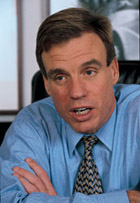 Fourteen fellow Colonials from across the political spectrum will serve in the 111th U.S. Congress. Returning to the political scene is alumnus Mark Warner (D.-Va.), BA ’77, who is now senator-elect for Virginia. Warner served as Virginia’s governor from 2002 to 2006. Read GW Magazine’s interview with Warner as he served as governor in the spring 2002 edition, which can be found in the archives section of the magazine’s Web site at www.gwmagazine.com.
Fourteen fellow Colonials from across the political spectrum will serve in the 111th U.S. Congress. Returning to the political scene is alumnus Mark Warner (D.-Va.), BA ’77, who is now senator-elect for Virginia. Warner served as Virginia’s governor from 2002 to 2006. Read GW Magazine’s interview with Warner as he served as governor in the spring 2002 edition, which can be found in the archives section of the magazine’s Web site at www.gwmagazine.com.
Also joining Congress is Pedro Pierluisi, JD ’84, who will be the resident commissioner of Puerto Rico.
Nine GW alumni incumbents won their bids for re-election:
U.S. Rep. Jason Altmire (D.-Pa.), MHSA ’98
U.S. Rep. Eric Cantor (R.-Va.), BA ’85
U.S. Del. Donna Christensen (D.-U.S.V.I.), MD ’70
U.S. Rep. John Duncan Jr. (R.-Tenn.), JD ’73
U.S. Sen. Michael Enzi (R.-Wyo.), BBA ’66
U.S. Rep. Steve Israel (D.-N.Y.), BA ’81
U.S. Rep. Sam Johnson (R.-Texas), MS ’74
U.S. Rep. Cliff Stearns (R.-Fla.), BS ’63
U.S. Rep. Robert Wexler (D.-Fla.), JD ’85
Three GW alumni in Congress were not up for re-election:
U.S. Sen. Kent Conrad (D.-N.D.), MBA ’75
U.S. Sen. Daniel Inouye (D.-Hawaii), JD ’52
U.S. Sen. Harry Reid (D.-Nev.), JD ’64
One GW alumnus incumbent retired:
U.S. Rep. Jim Ramstad (R.-Minn.), LAW JD ’73
One GW alumnus incumbent lost his seat:
U.S. Rep. Tim Mahoney (D.-Fla.), MBA ’83
And former U.S. Rep. Bob Barr, MA ’72, was the Libertarian Party candidate for president.
GW’s Graduate School of Political Management
The first professional school for politics in the country, GW’s Graduate School of Political Management celebrated its 20th anniversary last year. What started as a small charter school in New York has become, after 16 years as part of GW, a leading venue for political education that also includes a major institute complete with election polling. More than 1,500 alumni are out working in the field, including:
Janelle Carter, MA ’01, senior adviser and speech writer to Secretary of State Condoleezza Rice;
Anthony Coley, communications director in the office of Sen. Edward M. Kennedy (D.-Mass.);
Mohamad Elleithee, MA ’96, who served as a senior spokesperson for Sen. Hillary Clinton’s presidential campaign;
Deb Fiddelke, MPS ’94, who was deputy assistant to the president for legislative affairs after serving as special assistant to the president for legislative affairs;
Scott Reiter, MA ’06, managing director of the Realtors Political Action Committee of the National Association of Realtors, the nation’s largest trade association PAC; and
Brian Schoeneman, BA ’01, MA ’04, special assistant to Secretary of Labor Elaine Cho.
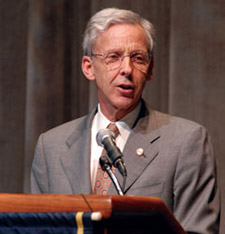
Graduate School of Political Management Dean Christopher Arterton is a nationally known political expert.
Jessica McConnell
With master’s degrees in political management and legislative affairs and a graduate certificate in political action committee management, the school offers a curriculum that integrates analytic science with politics. Course work covers lobbying, campaigning, corporate public affairs, issues management, leadership, fund raising, environmental politics, and quantitative strategy through classes that teach opinion polling, mass communications, organizing, and policy evaluation.
Dean Christopher Arterton joined the Graduate School of Political Management in its founding year of 1987. A 20-year teaching veteran with Yale and Harvard on his resume, Dr. Arterton also provides the school with considerable consulting experience on American public opinion. The author of four books, Dr. Arterton frequently provides commentary for the news media.
Within the school is GW’s Institute for Politics, Democracy, & the Internet. IPDI conducts research on trends; publishes studies and guidelines that that show how to make the best use of the new communication tools; and holds seminars and conferences that advocate best practices, teach new skills, and allow for exchange of ideas on the democratizing uses of the Internet and other new technologies.
IPDI’s annual Politics Online Conference, now entering its 16th year, has become a popular industry event. The institute also hosts monthly events that explore technology policy and emerging issues in the technology and political spheres. Also garnering attention are IPDI’s publications, such as the “Poli-fluentials: The New Political Kingmakers,” a follow-up study to IPDI’s 2004 publication on Political Influentials Online in the 2004 Presidential Campaign that looks at the media consumption, technology adoption, and political activism of the portion of the American population most likely to vote, donate, volunteer for political organizations, and influence the political beliefs—and actions—of their friends and neighbors.
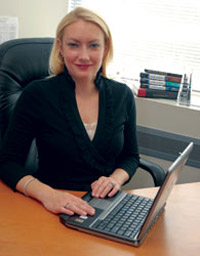
Julie Germany, MA ’03, director of GW’s Institute for Politics, Democracy & the Internet, was named a 2008 rising star in politics by Campaigns & Elections magazine.
Jessica McConnell
Other publications include The Politics-to-Go Handbook: A Guide to Using Mobile Technology in Politics; and The Political Consultants’ Online Fundraising Primer. IPDI’s blog (www.ipdi.org/blog) covers breaking news and analysis of practical politics, good governance, and technology.
IPDI’s director, Julie Barko Germany, MA ’03, was named a 2008 Rising Star by Campaigns & Elections magazine, along with alumna Carrie Giddens, MA ’01, communications director for the Iowa Democratic Party, and Daniel Jester, MA ’02, media supervisor for D.C.-based media firm GMMB.
Also within the Graduate School of Political Management is the University’s partnership in the GW-Battelground Poll, a nationally recognized series of scientific surveys that provides a bipartisan view of the democratic process. The poll is conducted by Republican pollster Ed Goeas and Democratic pollster Celinda Lake. GW became a sponsor of the Battleground Polls in 2004. The partnership brings resources to the nationally recognized poll and provides first-hand experience for GW students.
This year marks the GW-Battleground Poll’s 17th anniversary. Conducted by polling firms Lake Research Partners and the Tarrance Group, the survey has accurately portrayed the political climate through four presidential and three mid-term election cycles.
Research
In an era of slim election results and notorious hanging chads, wary voters want reassurance that their cast ballot is counted. GW doctoral student Stefan Popoveniuc and a team of researchers have invented a new vote-tracking system that seeks to provide proof through science.
“Right now, there is a voting system in this country that you essentially have to trust,” Popoveniuc says. “In God we trust. Everybody else bring data.”
The computer science graduate student and collaborators from other universities across the globe created a voting security system, called Scantegrity II, which uses computer software, invisible ink, and decoder pens to verify that the chain from cast ballot to vote tally isn’t broken.
Sound futuristic? Perhaps not for long—Popoveniuc, with a sample ballot and decoder pen in hand, explains that it is affordable, reliable, and ready for the polls.
The most recent in a series of vote-tracking systems that the research team has created, Scantegrity II uses invisible ink as a way to add security measures to existing paper optical scan ballots. Voters mark the bubble beside their candidate with a special decoder pen and, when chemicals in the pen react with the invisible ink, the bubble reveals a random, unique code. The voter can then record that confirmation code—a sort-of voting “receipt”—and later check it against the codes published by election officials on a Web site. If the voter sees her code for each race listed with her ballot number (let’s say, ballot 55, race 1, confirmation code ab), she can be sure the ballot was scanned accurately and the vote correctly recorded.
Scantegrity II has not yet been tested in a public election, but Popoveniuc explained the system during a voting technology forum on Capitol Hill in March. He touts several major advantages. For instance, the system doesn’t change voting procedures: A voter marks the optical scan ballot as usual, and then can privately choose whether to record and check the confirmation code. No special polling equipment is needed, either. The low-cost invisible ink is printed with the ballots, and the special-chemical decoder pens cost as little as $.50 each to make. And because the confirmation codes are random, voters retain their privacy, allowing anyone in the public to go to the Web site and audit the system. In fact, Popoveniuc argues that only 2 percent to 4 percent of the voters must verify that their codes correctly appeared on the Web site to mathematically prove that all votes are accurately tallied.
The confirmation process, Popoveniuc adds, is a much-needed assurance for voters and is as simple and familiar as reserving airline tickets: “It’s just like booking a flight. You get a certain confirmation number, and then you use that number for verification,” he says.
Scantegrity II comes at a time when a number of states are contemplating returning to paper-based voting systems after failed or troubled experiments with newer voting technology. Some states, such as New Mexico, Florida, and California, have already made the switch back to paper, most of them investing in the optical scan system, according to a 2008 online report by The Pew Center on the States, a nonprofit organization that works to advance state policies to serve the public interest.
While technology experts maintain that election systems will continue to move in the direction of electronic voting machines, Daniel Castro of the Information Technology and Innovation Foundation says Scantegrity II has sought to address the limitations of paper-based systems.
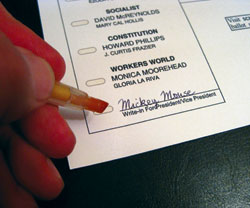
The Scantegrity II vote tracking system uses invisible ink and decoder pens (shown here) to reveal a confirmation number that voters can use to check against recorded votes on an election Web site.
Alex Essex
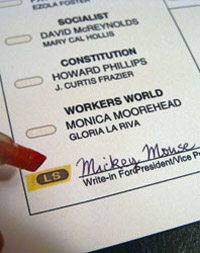
Popoveniuc and his team’s work “is an important step forward in improving the accuracy and trustworthiness of our elections,” says Castro, a senior analyst at ITIF, a nonprofit group affiliated with the high tech industry. “I expect that eventually this principle, known as ‘end to end verifiability’, will be used in all voting systems because it offers voters something they desperately want—proof that their vote has been counted.”
Popoveniuc, who came to The George Washington University in 2004, has been working on voter security systems since his undergraduate days in native Romania. While at GW, he met acclaimed computer scientist and inventor David Chaum during a presentation, and Popoveniuc suggested they collaborate. The two worked together with other researchers, including Popoveniuc’s GW advisor and computer science professor Poorvi Vorato, to create the earlier versions, called Punchscan and the original Scantegrity, before updating the system as Scantegrity II. The team has already won accolades, including a $10,000 first-prize for Punchscan in a July 2007 University Voting Systems Competition sponsored by the Nationals Science Foundation. Over the years, collaborators on the projects have grown. The report for Scantegrity II, which was published in 2008, has seven other authors who work from the University of Maryland, Baltimore County; University of Waterloo, Canada; University of Ottawa, Canada; Massachusetts Institute of Technology; and University of Newcastle upon Tyne in the United Kingdom.
Now Popoveniuc, Chaum, and their fellow researchers hope that this latest invention moves from theory to practice as more and more local and state authorities, even universities, are looking for ways to make voting simple but secure.
“If you go to a polling place and say, ‘I’m going to put this paper in, but I have no idea if it will count or not,’ then you may just not go at all,” Popoveniuc says. “But with Scantegrity II, we can prove, mathematically, that every vote counts. That way, we have more than a paper ballot. We have science.”
—Jaime Ciavarra

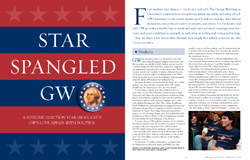
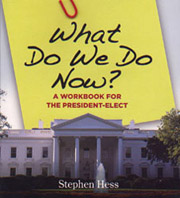 In a new publication called What Do We Do Now? A Workbook for the President-Elect (Brookings Institution Press, 2008), GW’s Distinguished Research Professor of Media and Public Affairs Stephen Hess draws from his long experience as a White House staffer and presidential adviser to propose what our country’s new leader can do to make a smooth presidential transition. Peppered with political cartoons and checklists, the paperback gives suggestions on everything from decorating the Oval Office to dodging Cabinet nomination battles.
In a new publication called What Do We Do Now? A Workbook for the President-Elect (Brookings Institution Press, 2008), GW’s Distinguished Research Professor of Media and Public Affairs Stephen Hess draws from his long experience as a White House staffer and presidential adviser to propose what our country’s new leader can do to make a smooth presidential transition. Peppered with political cartoons and checklists, the paperback gives suggestions on everything from decorating the Oval Office to dodging Cabinet nomination battles.